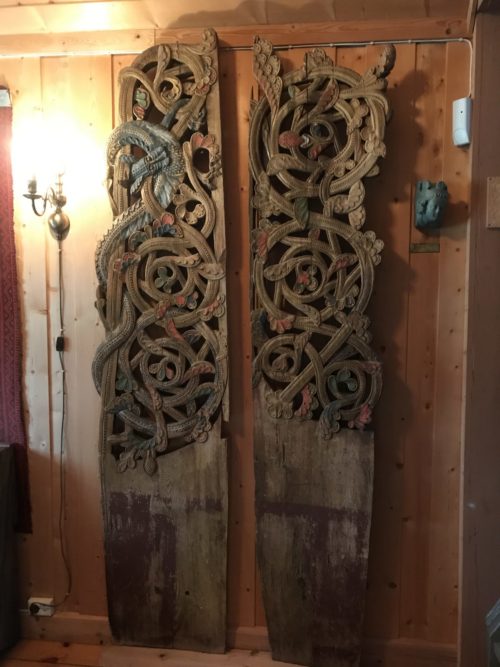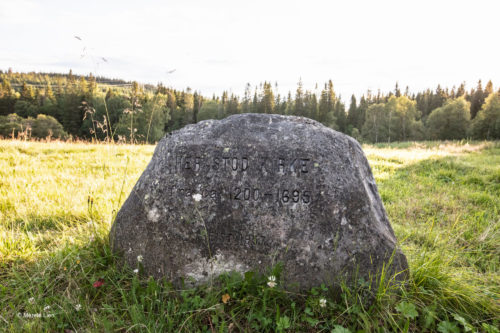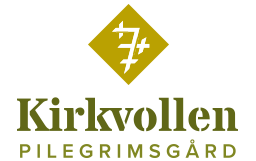The first church in Tydal was located at Kirkvollen.
That is about 8 km up the valley from the church at Aunet, which is dated back 300 years. There is little knowledge about the oldest church.

There are no known written sources, and therefore very few remaining items originating from the church. But what we know for certain is that two richly carved ornaments in wood, today to be found at the porch of Tydal Church, originate from the Kirkvollen Church. There are fretwork ornaments are estimated to date back to the transition between the Romanesque and Gothic period, around year 1200. It is therefore believed that the church was built around this date, probably as a stave church.
The exact location of the church was unknown until 1983, when the foundations were revealed. The wall consists of flat stones in a continuous square just below the peat. A representative from Riksantikvaren made his registrations, and the peat was laid back again. A visible stone was placed in each corner. The uncovered wall showed that the church was 7,5 × 6,5 meters, - about 50 sqm, and could house 70 to 80 persons. There has not been found remains of choirs or sacristies, but so far there have been no thorough investigations. According to registrations of Riksantikvaren, the site was officially protected.

The cemetery is clearly visible with unevenness resulting from the graves. During the building of a garden in 1938, a skull was found a little outside the marked cemetery, which indicates that the cemetery was larger than it appears today. There is still a grave that has been conserved. It is a rather thin tiled slope with recessed inscription: O. P. S. ANNO 1664. It is said that it is the grave of the last person from Kirkvold to be buried here. This was, according to the village book, Ole Pedersen, who was registered in a tax list from 1629, and in the koppskatteliste (head tax) of 1645. It is said he died when a heavy load fell over him in the Fossbakkene.
It is said that one of the doors at Kirkvolen is a church door. Hinges and locks of iron are specifically elaborated. The door is about 1 meter high and 82 cm wide, and is made of two sculptured trenches with two battens.
At Sødal Nordre in Brekken you can find a carved cock in tree, probably originating from the old church in Tydal. It is 3-dimensional, finely shaped and painted in red and green scratch. In upright position it can be rotated around an iron rod over the fireplace shelf. There is a theory of how the cock may have arrived in Sødal. Around 1770, two sisters, Ragnhild and Anne Eriksdatter Stuedal, married Lars Henningsen Sødal and Henning Saxesen Kirkvold respectively. The relationship became a possibility for exchange of gifts and inheritance.
The cock is well-known from Christian symbolism, for example the "petershan" from the high priest's farm, or as a vigilance from the church spirit. A carved and gilded angel was previously found at Sødal, which confirms the connection back to old church interiors.
At the same time as the foundations of the church were discovered in 1983, an old coin was found. A professional revealed that it was embossed in Flanders between year 1200 and 1300. It is now exhibited at Tydal Museum.
From the booklet: “Tydal Kirke 300 years 1696 – 1996” written by Per Kirkvold.
The churches of Tydal
We can say with certainty that the first church in Tydal was located at Kirkvollen. The majority lived along Tya, so Kirkvollen was a natural centre. We know little about this church. But experts agree upon the fact that there has been a stave church, listed around 1200; during the difficult period of history in the book "Civil War 1130-1240". This conclusion is based on the two beautifully carved churns that were moved from the old church to the new one on Aune, and have been placed one on each side of the choir. Now they are in the armory. Runic letters are found on one.
We know little about how the old house of God looked, only that the foundation wall was 12 inches square. The Novstens remained in place until around 1870. The grave can still be seen, and a gravestone is stored at Kirkvold. It has the inscription 0 P S Anno 1664, and was on the grave of Ole Pedersen Kirkvold, who is mentioned in taxpayer numbers for 1645. At that time he was then a widower, with a son and a daughter. It is mentioned that this Ole Pedersen died during high-speed driving in the Fossbakkene. The heavy load rolled over him.
At Kirkvollen there is a small door that is said originates from the old church, and in the village museum you can find a carved rosemary foal, which also has been on the door. A candlestick from 1602, which Jon Næsvold gave to the Stuedal Chapel at the ceremony of the chapel in 1957, was, according to the tradition, used in the old world church.
It is unknown how many worship services were held until 1589, when 4 were ordained.
There is also little tradition connected to the church house at Kirkvold. However, it is said that the priest never did use the church bells before Jo Rote and Håkkå Skørbergåsa had arrived, or you could hear them whistle. They lived opposite each other, both at the very end of the village, and had 20 km each way to church.
After 500 years, the church was completely dilapidated. It is said that during the summer the priest held the sermons outside. The last officiating priest vas Kristen Jensen Bloch.
At the consecration of Stuedal Chapel at the old church location, a memorial stone with an inscription revealed that the church had stood there from approximately 1200 to 1695. Bishop Fjellbu spoke, and this gathered a lot of listeners.
From: “Tydalsboka”, published in 1972 by Tydal municipality
Tydal church from 1690
........................ ..
On the smaller bell it says: "Jasper Moer me fecit Matheus est Nomen meum 1527". This one is a few hundred years older than the first one, and has been used in the stave church at Kirkvollen. However, this is not certain. The tradition says it has been in a castle in Copenhagen. It shows marks from hammering on the outer side. It is therefore likely that it once belonged to a clock work. However, 160 passed from the clock was cast until the consecration of the church of Aune.
From: Article in newspaper, cut out by Jon Næsvold
